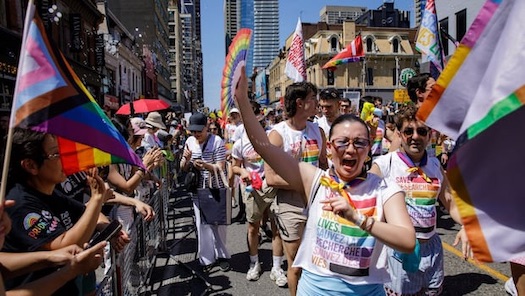Tens of thousands of marchers and spectators celebrate diversity and inclusion at annual LGBTQ+ event
Toronto – More than 25,000 marchers transformed the streets of Toronto into a vibrant celebration of love, diversity, and inclusion as they made their way to Nathan Phillips Square during Sunday’s annual Pride parade.

The event, which has become one of Canada‘s largest LGBTQ+ celebrations, drew hundreds of thousands of spectators who lined the parade route to show their support for the community.
The parade, which began at Bloor Street and proceeded south along Yonge Street before culminating at the iconic city hall square, showcased a remarkable display of unity and acceptance.
Participants included community organizations, local businesses, political representatives, and advocacy groups, all united in their commitment to advancing LGBTQ+ rights and visibility.
Community Organizations Lead the Charge
Leading the procession were several prominent LGBTQ+ advocacy groups, including Pride Toronto, the event’s organizing body, and various community centers that provide essential services throughout the year. Representatives from The 519 Community Centre, a cornerstone of Toronto’s LGBTQ+ community, marched alongside youth organizations and support groups that offer resources for individuals navigating their identity journeys.
Local businesses demonstrated their commitment to diversity and inclusion by participating in significant numbers. Major corporations, small enterprises, and professional organizations created elaborate floats and displays that celebrated the community while showcasing their dedication to creating inclusive workplaces and services.
Political Support Demonstrates Progress
The parade featured strong representation from all levels of government, with municipal, provincial, and federal officials participating in the celebration. Toronto Mayor representatives joined Members of Parliament and Members of Provincial Parliament in showing their support for LGBTQ+ rights and the importance of continuing to advance equality measures.
This political participation reflects the significant progress made in Canada regarding LGBTQ+ rights over the past decades. The country legalized same-sex marriage in 2005 and has continued to strengthen protections for gender identity and expression through various legislative measures, including additions to the Canadian Human Rights Act.
Educational Impact Reaches Broader Audience
Beyond the celebration itself, the parade served as an important educational opportunity for attendees of all ages. Many families brought children to witness the event, using it as a teaching moment about acceptance, diversity, and the importance of supporting all community members regardless of their sexual orientation or gender identity.
Educational institutions, including universities and colleges from across the Greater Toronto Area, participated with student groups and faculty organizations. These academic communities used their presence to highlight ongoing research, support services, and campus initiatives designed to create safer, more inclusive learning environments.
Economic Benefits Support Local Community
The annual Pride celebration generates significant economic activity for Toronto, with estimates suggesting millions of dollars in tourism revenue, hotel bookings, restaurant sales, and retail purchases. Local businesses reported increased foot traffic throughout the weekend, with many establishments offering special promotions and Pride-themed products.
Street vendors, food trucks, and merchandise sellers created a bustling marketplace atmosphere along the parade route and at Nathan Phillips Square. The economic impact extends beyond the immediate event, as many visitors extend their stays to explore Toronto’s vibrant neighborhoods and cultural attractions.
Challenges and Continued Advocacy
While the celebration highlighted significant progress, organizers and participants emphasized that important work remains in advancing LGBTQ+ rights and addressing ongoing challenges. Issues such as workplace discrimination, healthcare access, and youth homelessness continue to affect community members, requiring sustained advocacy and support.
Mental health resources and suicide prevention programs received particular attention during the event, with several organizations distributing information about available services and crisis support options. These efforts reflect the community’s commitment to addressing the higher rates of mental health challenges faced by LGBTQ+ individuals.
Looking Forward to Future Celebrations
As the parade concluded at Nathan Phillips Square with speeches, performances, and continued festivities, organizers expressed optimism about future events and the community’s continued growth. Plans for next year’s celebration are already underway, with hopes of expanding participation and reaching even more community members.
The success of Sunday’s parade demonstrates Toronto’s position as a leader in LGBTQ+ acceptance and celebration, serving as a model for other cities working to build more inclusive communities. The event’s combination of celebration, education, and advocacy creates a powerful platform for advancing equality and understanding.
Audio Summary
Toronto’s annual Pride parade brought together over 25,000 marchers who processed through the city streets to Nathan Phillips Square on Sunday. The celebration drew hundreds of thousands of spectators in a massive show of support for LGBTQ+ rights and diversity. The event featured colorful floats, community organizations, and local businesses celebrating inclusion and acceptance in one of Canada’s largest Pride celebrations.